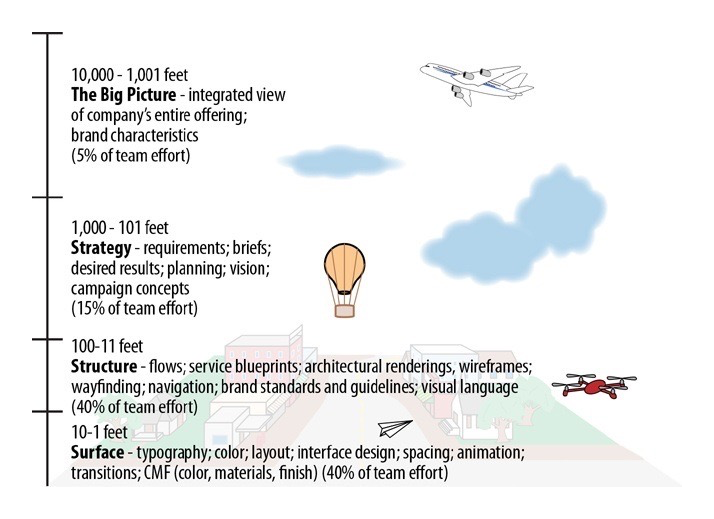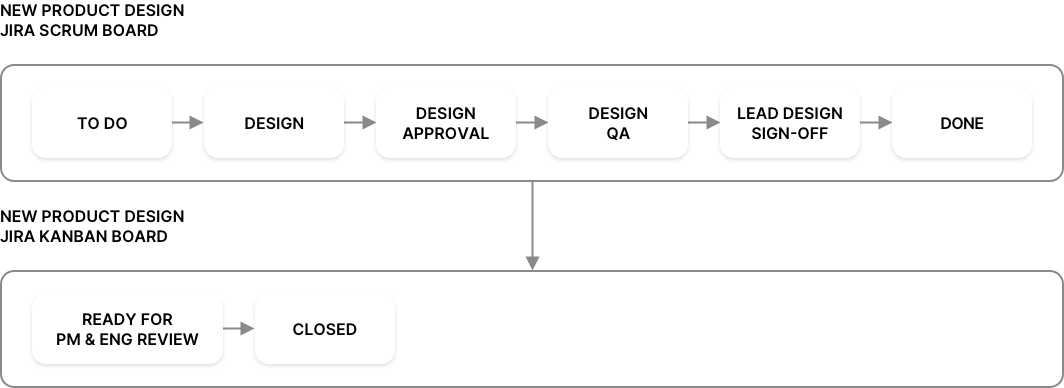Tools & Processes
One of my main responsibilities besides people management is evaluating the tools the designers use and the processes we built around them. But the Product Design Team doesn’t work in the silo, and our processes are tied to the other teams’ flows. So, the most challenging, existing, and at the same time most troublesome part in this was re-evaluating the processes of collaboration with other teams, like Engineering and Product. This required a good level of strategic thinking, problem-solving, communication skills, and in some cases, the ability to navigate political waters. So I had to develop these skills to succeed.
During my career, I helped to evaluate multiple parts of processes in the Crunchyroll organization. But probably, the most exciting was to perform analyses and changes in the workflows to achieve a 30% increase in the product design team’s productivity and a drastic decrease in stress level.
To perform these analyses, I used quantitative data collected from Jira and qualitative data we have received from the “life-quality” survey from our team members. I say “we” because this won’t be possible without the support, help, and guidance I have received from the Director of Product Design - Brian Johnson, and Product Design Program Manager - Marcel Sendrea.
Problem
Where is the Product Design Department’s place in the business planning and decision making in the company? - I believe that a representative from the Product Design should be at the same level as other stakeholders, like CPO, CTO, CEO, etc.
The problem with this is that it’s not common yet in the IT industry. A lot of companies slowly realize the value of having product design representatives at this level. Getting there takes a lot of effort and time. The Crunchyroll organization was no exception.
I joined the team in 2017. A lot of significant improvements happened by the end of 2021. The team managed to move from “surface” (producing UI and design deliverables of low quality) to “structure” (thinking about flows, architecture, visual language), and from “structure” to “strategy” (the setting of requirements, desired results, and planning). The team is currently in the stage of getting to the “big picture,” and it’s an exciting moment for me.

Image is taken from the "Org Design for Design Orgs: Building and Managing In-House Design Teams" book written by Peter Merholz and Kristin Skinner.
Back in 2019, the team was still at the stage of transitioning from “surface” to “structure.” Designers were tired and stressed. The team was delivering only 64% of committed points per sprint. The tasks and requests for new designs came from different parts of product and engineering organizations, and there was almost no planning. The team was in crunch time. My goal was to improve the situation.
Short-term solution
First, I analyzed the flow in our Jira board and identified the bottleneck in this process. I knew that removing the bottleneck is similar to treating the “symptoms” and not the disease, but, at least, it would buy me some time to think about how to resolve the issue.
After analyzing the Jira sprint reports, I saw that most tickets got stuck in the “product and engineering review” column at the end of our process.

I didn’t want to remove this important step from our flow completely. I just wanted to remove it from the sprint and allow engineers and product owners to spend on reviews as much time as they need, without forcing them to do this at the last minutes of the design sprint. So I worked with the Product Design Program Manager - Marcel. He has created a separate Kanban board for tickets finished by designers in a sprint. Product Managers and Engineers were tagged and asked to review the job designers did.

We then pitched this idea to the Director of Product Design - Brian. Brian was open to performing this change. In a short period, he came up with an official email and meetings to share news about the changes in our flow.
This improvement led to about 10% in the team velocity, increasing the percentage of delivered VS committed points to almost 75%. At the same time, this has increased designers’ feeling of accomplishment. They felt they were doing better.
Long-term solution
The long-term solution was obvious to me, but I had no idea how to implement it. It consisted of two things:
- improving the quality of UI and UX design;
- better planning.
To improve the quality of the designs, we had to focus on UX more and start creating information architecture, user flows, building wireframes and prototypes, making user testing, etc. Besides that, we had to educate Engineering and Product organizations and explain the values of these steps.
To improve planning, I had to lay down a process that designers could follow.
Luckily, back in 2020, I replaced our Mobile Lead Product Designer, who was on maternity leave. I was responsible for tasks management and design quality in the mobile design team. I saw this as an opportunity to implement the new process and see how it would work.
I wanted to hit two birds with one stone: improve the design quality and start planning. Also, in my circumstances, these two things had to be addressed simultaneously. I have planned what needs to be done and decided that we will start working in a new way within the following request from a Product Manager.
The plan was to:
- Analyze with the team the request that came from a Product Manager, whether it’s a user story or an abstract description of an issue.
- Think about possible design steps or technics we can use which will help us deliver the best possible design quality.
- Create a google spreadsheet with each step, including the dependencies and notes (we called it “job breakdown”).
- Make an estimation session with the team and provide a high-level estimation for each step.
- Put these estimations on the timeline and analyze how many designers can work simultaneously on the feature.
- Share the timeline and job breakdown with the Product Owner, negotiate the timeframe.
- Start working, adjusting the process during the execution if needed.
The first request came in a week from the video player Product Owner. They asked us to deliver designs for new functionality in two weeks (one sprint). I knew that it was impossible to design what they were requesting in two weeks, so I have explained that to understand whether we can do it in two weeks, we need one day with the team to analyze the requested task.
The following day the team discussed the request and created a long list of questions to understand better what needed to be done.
In 2 weeks, PO has provided answers. This allowed me to get to the following four steps: think about the design approach, put it down in a doc, estimate, create a timeline. We took about five days to do it. When we were ready, we saw that it’d take us about 12 weeks (6 sprints) to deliver everything the Product Owner wanted.
As the next step, I have scheduled a meeting and shared the job breakdown with high-level estimations with PO. PO tried to push back on the steps I proposed, but I had a lot of arguments to explain why they are necessary if we want to deliver everything they have requested.
During the following two weeks, the PO modified the requirements and collaborated with the product design team to understand how to deliver designs faster. As a result, we’ve agreed on functionality that was still good for our users and would take us four sprints to deliver.
After four weeks, the design team has delivered everything that we had planned. And the experiment showed great success.
As the next step, I wrote documentation explaining the process. We used it for each new request that was coming from the Product Organization. As a result, in 2 months, we have created a plan and timeline for multiple features. The analyses showed that designers were performing better. During the retrospectives, they shared that they didn’t feel stressed anymore. Designers didn’t have to work overtime to deliver the designs. Everything was planned, structured, and prioritized.
As the final step, I have presented this approach to the other design teams. During the following half of the year, I helped them implement new processes, create job breakdowns, and build a strong backlog with a timeline.
Result
The final results were fantastic. By mid-summer 2021, we managed to raise the Product Design Department’s productivity to 91%. Just to remind you, in mid-summer 2019, the team was delivering only 64% of committed points.
Several important notes: in 2019, the team was working five days per week from the office. During summer 2021, the team was working four days a week from home. Of course, these great results were achieved not only by the two solutions described above. But they became the main factors, which allowed to make many more small life-quality improvements.